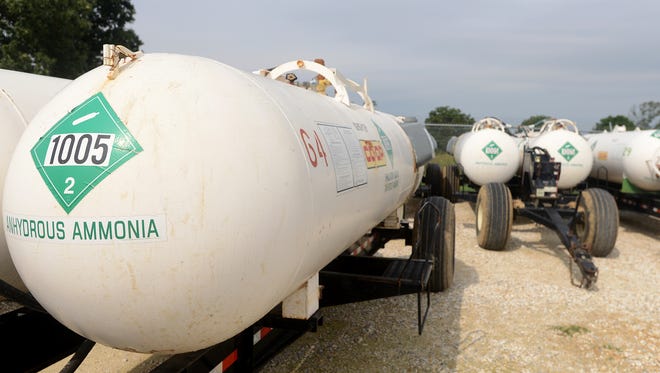How to handle the dangers of anhydrous ammonia leaks

There are a lot of hazards in the agriculture industry, but anhydrous ammonia is one hazard that deals a lot of damage in a small amount of time.
Anhydrous ammonia, which is a gaseous or liquid form of ammonia that lacks water, can cause chemical burns in a matter of seconds. The chemical is used in the ag industry for fertilizing fields and is carried in large tanks.
Dan Neenan, director of the National Education Center for Agriculture Safety, said during an AgriSafe webinar that the biggest concerns for handling anhydrous ammonia is the size and safety of storage equipment, like tanks, as well as the valves working properly to prevent leaks.
"Due to recent industry concerns, with double tank configurations and the size of equipment, we're seeing more anhydrous releases," Neenan said. "There's also issues with excess flow valves not shutting off when a release occurs, and depending on the temperature and the size of the valve, it makes it difficult for farmers and farm applicators to shut off that tank when they leave."
While many small family farms are not subject to regulations under the Occupational Health and Safety Administration, Neenan said it's still good to look at OSHA rules and implement them at your own operation if you handle anhydrous ammonia in any capacity.

Neenan said employees working with anhydrous ammonia should know that any moist areas of the body, like the eyes, mouth, armpits and groin, should be completely protected with personal protective equipment. That's because when anhydrous ammonia is leaked into the air, it will immediately seek out a source of water or a wet area because it lacks water, he said.
Anhydrous ammonia should also be stored in up-to-date, safe storage containers that receive regular preventative maintenance. Neenan said employees should also be given training courses on how to handle and maintain the equipment and what to do in an emergency, like a leak.
"Folks that use it need to have the proper training, have respect for the product, wear protective gear and slow down," Neenan said. "This is something that you don't want to speedily go through the connections with. You want to make sure that you're taking your time and you're doing it right."
For instance, Neenan said tanks should always be carrying at least five gallons of water for emergencies, should be properly and securely attached at the hitch and must also include proper signage and placards. He noted that most hoses expire after five years and should be replaced regularly. And while the chemical is not considered to be flammable, it can still ignite under certain conditions, so don't weld or use any fire source when nearby.
Neenan said the major characteristics of anhydrous ammonia are its strong odor, lack of color and liquidation under pressure. While you often can't see it, your nose will be able to detect if there's a leak. It's also corrosive and causes chemical and freeze burns if it touches any part of the body, Neenan said. Anyone who receives those burns should be immediately treated by medical professionals.
"These burns can occur instantaneously. It's a powerful alkaline with corrosive properties, and because of that, burns can go deep," Neenan said. "If it's a full thickness burn, it's burning through the nerve endings and typically folks who are burned can't feel it. That's the worst burn."

Most accidents happen due to uncontrolled release of anhydrous ammonia, Neenan said. That's usually caused by improper procedure while opening or closing valves, untrained employees using the equipment or equipment failing due to age or malfunction. If a leak happens, make sure to evacuate everyone from the building, including any animals if possible, and call the fire department. It's also a good idea to shut off any HVAC units, Neenan said.
Neenan said if you ever get caught in a cloud of anhydrous ammonia, head to higher ground because it will settle in low-lying areas. Be careful, he added, because wind direction can quickly change where the cloud is headed. If you're driving, it's smart to drive into the wind to escape the clouds going the opposite direction.
"We talk to the fire departments all the time about this because you see firefighters getting burns to their feet and ankles," Neenan said. "As they're going down to work on that (leak), the anhydrous is still down in the ditch and can gain access to their skin to be able to do that."
When treating injuries, use large amounts of water to flush out the eyes. Carefully remove any clothing, because freeze burns may cause the clothing to stick to the skin, and taking the clothing off could remove the skin. Move the victim to fresh air and perform CPR if their breathing stops – inhaling anhydrous ammonia can cause lung burns and chest pain.
Proper PPE includes a full-face respirator, long cuffed rubber gloves and chemical splash goggles. You should also wear heavy-duty clothing made of tightly-woven material so any loose chemical will have a harder time getting to your skin. Neenan said you should fit-test respirators annually and keep them in a dry, clean place when not in use.
"To ensure worker safety, workers must be adequately educated about the procedures and the personal protective equipment required to safely use this product," Neenan said.